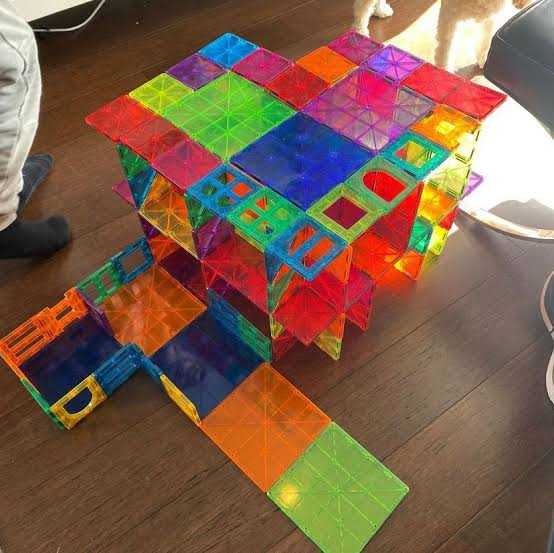Magnetic tiles are a type of educational toy that consists of small, flat pieces with magnetic edges that can be connected together to build structures, such as buildings or bridges.
The tiles, which are often made of plastic or foam, are designed to be safe and easy for children to handle, and they can be used to help children learn about geometry, spatial reasoning, and engineering principles.
Some common shapes for magnetic tiles include squares, triangles, and rectangles, and they may come in a variety of colors. Many magnetic tile sets also include additional pieces such as wheels, doors, and windows, which can be used to add more detail and functionality to the structures that children build.
Read Also: 6 Factors to Consider Before Setting Up a Tilapia Fish Farm for Profits
Interesting Facts About Magnetic Tiles
- Magnetic tiles are believed to have been invented in the early 1990s, although the exact date is unclear.
- The first magnetic tiles were made of foam, but today, many magnetic tiles are made of plastic.
- Magnetic tiles are often used as an educational tool to help children learn about geometry, spatial reasoning, and engineering principles.
- Many educators believe that playing with magnetic tiles can help children develop important skills such as problem-solving, creativity, and fine motor skills.
- Some magnetic tile sets include additional pieces such as wheels, doors, and windows, which can be used to add more detail and functionality to the structures that children build.
- The magnets used in magnetic tiles are typically very weak and are not strong enough to pose a choking hazard.
- Some magnetic tile sets include a storage case or bag, which can be used to keep the tiles organized and protected when not in use.
- Magnetic tiles can be used by children of all ages, although they are often most popular with younger children.
- Many magnetic tile sets come with a set of building instructions or ideas, which can be used to help children get started with building different structures.
- Some magnetic tile sets are designed to be compatible with other popular construction toys, such as LEGO bricks or Mega Bloks.
- Many companies produce magnetic tiles, and there are many different brands available on the market.
- There are many online resources available for parents and educators who want to learn more about how to use magnetic tiles in the classroom or at home.
Benefits Of Magnetic Tiles
Read Also: 30 Proven Health Benefits of Okra (Lady Finger)
There are many benefits to using magnetic tiles as a learning and play tool for children. Some of the main benefits include:
- Improving fine motor skills: Manipulating the small, magnetic tiles requires children to use their fine motor skills, which can help improve dexterity and hand-eye coordination.
- Developing problem-solving skills: Building with magnetic tiles requires children to think creatively and find solutions to problems that may arise during the construction process.
- Enhancing spatial reasoning skills: Magnetic tiles help children understand spatial relationships, such as how different shapes fit together and how to create stable structures.
- Encouraging creativity: Children can use magnetic tiles to create a wide range of structures and designs, encouraging them to think creatively and use their imagination.
- Encouraging teamwork and socialization: Magnetic tiles can be used as a group activity, encouraging children to work together and communicate with each other.
- Supporting math skills: Magnetic tiles can be used to teach children about shapes, patterns, and symmetry, which can help support their math skills.
- Enhancing language skills: As children play with magnetic tiles, they may use descriptive language to talk about their creations and share ideas with others, which can help improve their language skills.
- Supporting STEM learning: Magnetic tiles can be used to introduce children to concepts in science, technology, engineering, and math (STEM), helping to lay the foundation for future learning in these areas.
Read Also: Why Do Kids Love Calico Critters?
